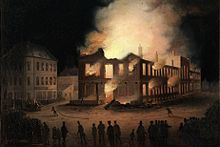This article's lead section may be too long. (April 2023) |
| Burning of the Parliament Buildings in Montreal | |
|---|---|
 Joseph Légaré, The Burning of the Parliament Building in Montreal, about 1849 | |
| Location | St. Anne's Market, Old Montreal |
| Coordinates | 45°30′02″N 73°33′22″W / 45.5005°N 73.5560°W |
| Date | April 25, 1849 |
| Target | Parliament of the Province of Canada |
Attack type | Fire |

The burning of the Parliament Buildings in Montreal occurred on the night of April 25, 1849, in Montreal, the then-capital of the Province of Canada. The way the matter was handled by then co-prime ministers of the united Province of Canada, Sir Louis-Hippolyte Lafontaine and Robert Baldwin, helped develop the Canadian democratic tradition.
The St. Anne's Market building lodging the Legislative Council and Assembly of Canada was burned down by Tory rioters as a protest against the Rebellion Losses Bill while the members of the Legislative Assembly were sitting in session. There were protests right across British North America. The episode is characterized by divisions in pre-Confederation Canadian society concerning whether Canada was the North American appendage of the British Empire or a nascent sovereign nation.
In 1837 and 1838 Canada was hit by an economic depression caused partly by unusually bad weather and the banking crisis in the United States and Europe. A number of Canadians in Upper and Lower Canada (now the Canadian provinces of Ontario and Quebec respectively) demanded political changes in response to the economic downturn. The Rebellions of 1837 occurred first in Lower Canada, then in Upper Canada. After Lord Durham's Report political reforms followed the rebellions.
Many key leaders of the Rebellions would play focal roles in the development of the political and philosophical foundations for an independent Canada, something achieved on July 1, 1867. The Rebellion Losses Bill was intended as amnesty to former rebels (permitting them to return to Canada) and indemnity to people financially hurt by the rebellions. Lord Durham had granted an amnesty to those involved in the first rebellion only. Despite an amendment stating that only those that had not pleaded guilty or been found guilty of high treason would receive compensation, the bill was decried as amounting to "paying the rebels" by the opposition.[1] The bill was eventually passed by the majority of those sitting in the Legislative Assembly, but it remained unpopular with most[citation needed] of the population of Canada East and West. Those in Montreal decided to use violence to demonstrate their opposition. It is the only time in the history of the British Empire and Commonwealth that citizens burned down their Parliamentary Buildings in protest.[citation needed] The Parliament buildings were destroyed by the fire, and a consequent collection of historical records kept in the parliamentary library was lost.[2]
Despite the tense situation and the actions committed by the mob, Lafontaine proceeded cautiously, fought off armed rioters who had shot through his window, and maintained restraint and resolve in his actions. Jailed members of the mob were released on bail soon after their arrest and a force of special constables established to keep the peace. Though there was public concern this might be a crushing blow to the reform movement, Lafontaine persevered despite the opposition, and would continue in his role developing the tenets of Canadian federalism – "peace, order, and good government". Within a decade public opinion had shifted overwhelmingly in the development of a sovereign Canada.
- ^ Royal (1909), p. 305.
- ^ Cite error: The named reference
:0was invoked but never defined (see the help page).
